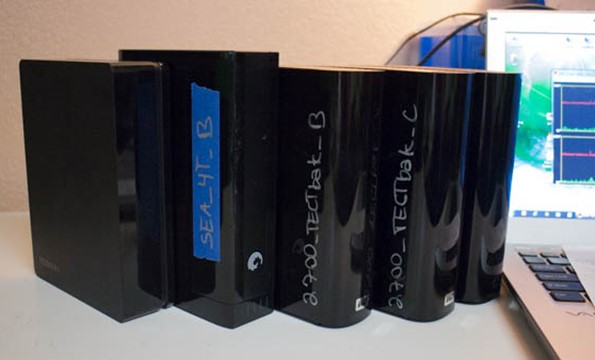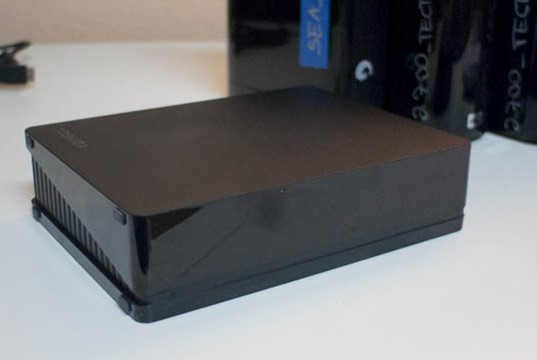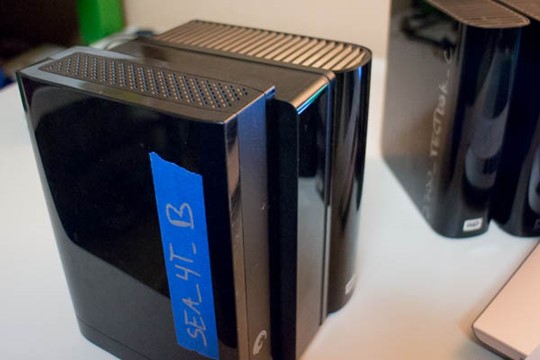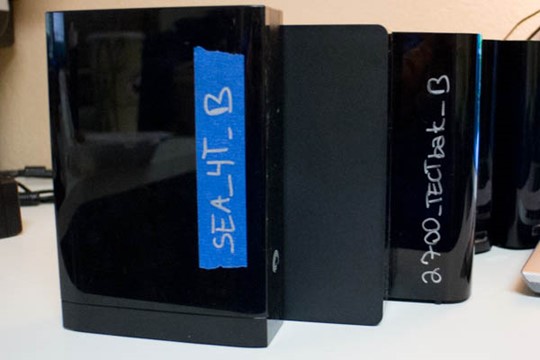I own a lot of external hard disks, there's really no getting around it. In the space of about eighteen months, I've owned thirteen external USB 3.0 disks. I only have two machines that have USB 3.0 ports, but USB had already displaced USB 2.0 as the standard for 3.5 and 2.5-inh external disks by the time I started buying external disks in earnest again.
I have a reasonably long history with external disks, and my first one was an 80 gigabyte unit in an enclosure that supported USB 2.0 (before I even had any machines that had it) and 10/100 ethernet, via the "network direct attached storage" protocol/standard that a company called XIMETA had been working on. It worked well enough and took several years to finally kick the bucket. After that, I owned a "self-built" drive, which was an IDE drive in an enclosure purchased on NewEgg, and then I acquired one of the early Western Digital MyBooks which had two Firewire 400 ports as well as USB 2.0 and an Iomega ScreenPlay at about the same time. After that, I owned another MyBook until I acquired TECT and tentatively gave up on external hard disks.
Windows 8 then came out and promised to make chaining together a bunch of disks for whatever purpose and of whatever interface easy, painless, and durable. To try this out, I tried and failed to get a trio of 2TB external Seagate "expansion" drives to do anything, and then I tried the same thing but with a Dell Inspiron 570 as the base system. Running out of ideas, I decided to shuck that trio of disks and put them inside the 570, where they've done well, but I've certainly been forced to think about the viability of off the shelf consumer hardware when building a large storage system. If I had a lot of time and money, I'd pick up a SATA card or two for the machine, some enhanced power wiring, and figure out the best way to mount a large number of disks inside a PC minitower (which may or may not involve something like erector set and removing some of the internal components.
Before that came to fruition though, a local store had an extremely good sale on 4TB (!!!) external disks, this time Seagate GoFlex Desk drives, on sale today under the brand name "Backup Plus" – but they're the same disks in the same plastic cases on the same flexible (eh, eh?) that purport to offer flexibility of deployment. I ended up buying a second disk on the same or a very similar sale before the model I'd been buying went away, and have had nothing but poor luck with the pair of them. It turns out that Windows 8 likes them slightly more than Windows 7 did, and the one disk that remains of the pair (because one of them truly did totally die) works even better on Mac OS X than it did on Windows, but I absolutely do not recommend this particular disk.
So, when it came time to think about how I was going to do backups on TECT again, I was understandably a little bit shy of both Seagate, whose USB controllers have proven to be the worst and quickest to die of any external disk I've heard of, and of 4 terabyte mechanisms, with which I've had 100% failure rate so far. (I suspect this is actually the fault of Seagate's USB controllers and not of their mechanisms, because nearly every internal disk on every computer I own is Seagate and those drives have all been as reliable as I expect from a disk.) I ended up buying a Western Digital MyBook at 3 terabytes on a good deal, and then setting it aside. Another good deal came up at another store and I bought that disk and set it aside.
A Fleet of MyBooks
After realizing that an LTO 6 mechanism and its 2.5TB (native) media was out of reach for the near term, I started looking at both regular USB external hard disks and RDX cartridges, and determined that for the near future, external USB 3.0 drives should serve my backup needs. With that in mind, I promptly went to buy two or three more of the 3TB WD MyBooks and have them all neatly labeled as TECT backup disks. This saves me from buying a copy of Acronis Backup & Recovery which supports tapes as well, and if necessary, I can scale my disks to 4TB units later, or span backups across multiple disks.
As with all previous Western Digital MyBook products I'd owned (which had been two or three,) the new disks performed well under all conditions – connected to TECT, my work PC, Macs, Windows 7, Windows 8, and on both USB 2.0 and 3.0 connections. I like Western Digital's cables and power adapters (although that doesn't matter too much and I've been using Seagate's bundled cords with my WDs with no issues) and the design means that the disks run cool.

There is a third major vendor of USB external hard disks though, one I've honestly never investigated before: Toshiba makes a reasonably well liked of external disks called the Canvio Desk. There is not a 4TB SKU available yet, but the 1/2/3 terabyte versions all have USB 3.0, a good power supply, and come in a trim mechanism that officially allows the device to be placed horizontally or vertically.
Let me not understate the amount that I appreciate that you can run this disk horizontally, and that Toshiba supports it. I'm normally totally comfortable with my disks running vertically, but there are a few situations where I would be more comfortable with a disk laying horizontally, purely for physical stability issues. The main one here is actually the use case this disk will be going into: I am going to put it on top of my PC at work, a minitower that sits under my desk and does get kicked and hit with a vacuum cleaner from time to time.
Initial Impressions
The out of box experience is really good. You connect the disk to your machine and it's just there, available. Both Western Digital and Seagate have auto-runs and attempt to sell you on premium software that's specific to the disk line you're using. The disk includes NTI Backup software, but I haven't installed it on any of my machines. I may try the software out on one of my machines at work, but for the time being, I have no particular need for more backup software. One nice thing is that it looks like NTI Backup can do both file/folder backups (a feature of WD SmartWare and Seagate's software) as well as system image backups (True Image WD Edition) and scheduled system image backups (per StorageReview), and it may even allow scheduled, incremental disk image backups. I will also test to ensure that NTI backup runs without a Toshiba drive connected, which would provide it yet another advantage over TrueImage WD Edition, which will run only when a Western Digital disk of some sort is connected. TrueImage WD Edition also does not come on WD's external hard disks, you need to go look for it on their web site.

The disk performs well. To be honest, I only have one machine at home with USB 3.0 and that machine only has one port. That machine already had its data disk connected, and it's working on a big project already, so I've decided to do some initial testing using a Windows 8 machine that has USB 2.0 ports. The testing is good. The drive mounted immediately and has a nice custom icon. I have copied just shy of 300 gigabytes to it with no interruptions so far. It is (as all hard disks for several years have been) capable of saturating USB 2.0.
Running Temperatures
I have only been using it in horizontal mode so far, where there is no possibility of it being knocked over by an enthusiastic cat (or by a vacuum cleaner when it is at work.) Temperatures are kind of high: Acronis Disk Monitor says the disk is reporting a 120° Fahrenheit, with a recommended temperature of 107°. I haven't actually researched disk running temperatures in detail before, so I just can't claim to know if this is a good temp or not. I have had disks run hot before and the only consequence tends to be that they're angry, so my guess is that if the controller Toshiba has put in this enclosure is any good, the mechanism will continue to run.
When running vertically, under load, the disk reports a temperature of about 111° Fahrenheit. This is lower than the peak temperature I saw reported when the unit was lying flat, but there are some vents closer to the top that might be letting some of this heat out. Hypothetically, there is also more surface area of the plastic case touching cold air, which may actually make a difference. I may need to test stressing it again with some MyBooks flanking it, possibly generating their own heat, so as to get an idea of what it might be like if some Canvios were stacked or just positioned next to one another.
The disk enclosure is slightly warm to the touch. I don't have the money to go buy a bunch of them in order to test this, but I would really like to know is whether or not the heat effects of multiple units stacked together (say, a Windows 8/2012 Storage Spaces group) is enough to cause concern. I wouldn't be worried running a bunch of Western Digital MyBooks next to one another (even fastened with Command Strips, so as to prevent them from falling over) but while the Canvio Desk has more ventilation than the Seagate GoFlex Desk, I think the actual lynchpin to its success will be its USB controller.
The Enclosure
Speaking of the enclosure. The Canvio Desk is a very classy drive. I personally like the way the Western Digital MyBooks look, but they match almost nothing that I own, because they (and the Seagate GoFlex drives) have a high-shine plastic finish with silver accents. Most of the other computing equipment I own is matte black or a flatter silver. (Not counting the things I have that are beige/platinum/white plastic in some variant.) Sitting next to a machine like my ThinkPad T400, I can't suppress the feeling that the Canvio Desk is somehow the correct external drive. As though for whatever reason, it would be incorrect to use another drive. There's a band around all four edges that is a similar high-shine plastic to the MyBooks, but with the Canvio laying on its side, I don't see this particular finish as being intrusive, the way I would if the high-shine finish continued to the front.

Differentiation in the Industry
External drives are one of the few ways it is still possible for the manufacturers of external drives to differentiate themselves from one another. Western Digital has chosen a somewhat boring but really tried and true approach to building an external drive that's fast and reliable. Seagate has built an interesting but immature ecosystem of drives and accessories which changes slightly too often to really deserve being thought about like an "ecosystem. Toshiba has not been nearly as generous on the cooling front as Western Digital, but it would appear that the cooling matters slightly less than I tend to think it does, and that Toshiba has reached a medium point between drives and controllers that cook themselves within hours of coming out of the box, and drives that are as big and open as Western Digital's.
The other variable is that Western Digital and Seagate each have external drives on a lower product tier. These lower end drives are each designed to lay flat on a desk or on top of a computer tower and provide additional hard disk space and each of them has very little cooling. I have owned several of Seagate's Expansion drives, all of which promptly cooked their controllers, but I have never owned a WD Elements drive. (Also worth noting: The Elements retains a Mini USB 2.0 interface while the Expansion has been a USB 3.0 device for two generations now.) Toshiba does not have a similar product line in this entry, I suspect in part because the Canvio Desk fills this role for them, and because the Canvio Desk is designed to be positioned both vertically and horizontally, so there does not need to be a separate product for each of those physical positions.
In a true round-up of hard disks, I think that some information about the Western Digital Elements disk would be the key to understanding how cooling (or a complete lack thereof) affects external hard disk drives. The Elements looks like it's a pure plastic box with a USB and power cord on one end, meaning that it should get at least as hot as the Canvio Desk and the Expansion and GoFlex drives do. If the problem is in Seagate's USB controllers, then the Element will work properly regardless of how hot it gets. If the problem is in keeping a drive and its controller cool, then the Elements should cook itself under sustained load, such as a disk benchmark or copying several terabytes worth of files from TECT to it.

I have nowhere near the sample size of Toshiba Canvio Desk units as I do Western Digital MyBooks. In a perfect universe, I won't get to that level, and even though I like the one that I have, I am more or less standardizing on the Western Digital MyBook because the share a basic physical concept from generation to generation, while I can't count on Toshiba or Seagate to do the same thing.
Final Words
For somebody who isn't a control enthusiast, I have no problems at all recommending the Toshiba Canvio Desk. If you have a computer with USB 3.0, its performance should be no problem, it may even be faster than your computer's internal disk if you have a desktop with an old drive or a laptop with a spinning hard disk. If your computer has USB 2.0 ports, then every USB 3 drive you can get will saturate the connection on your computer. The key differentiator here is that the Toshiba will not cook itself in the process, and that you can position it however you like.
The only identifiable downside is that you cannot (yet) purchase the Toshiba Canvio Desk in a 4TB capacity. If you absolutely must have a 4TB drive, I recommend either the Western Digital MyBook, or purchasing an internal 4TB mechanism and putting it into an external enclosure on your own. If you're looking for a fleet of external disks for use in some unusual configuration, it's a toss-up between the Canvio and the MyBook. Toshiba has not had this case design as long as Western Digital has had the same basic shape for the MyBook, so if you're looking for something that you expect or hope will be using the same enclosure in two or three years, you may be out of luck. In addition, MyBooks (even the new generation) continue to have better heat dissipation, and I am not exaggerating when I say that I have never seen any of my MyBooks run at over 100° F.
The real test for me is going to be how long it lasts when connected to my work machine for a long time. It didn't take more than a few weeks for me to determine that the Seagate GoFlex disks would not be a good long-term backup solution on my work PC. The disk ran extremely hot, the whole system often seized up when the controller encountered an error, and every two or three days, the disk would need to be disconnected and reconnected when I found out that the GoFlex had just fallen off the bus and let its motor spin at top speed, heating the disk up further. The Seagate GoFlex (now called Backup Plus) is a terrible product and the Toshiba Canvio Desk is an acceptable one.
There's a very short list of external hard disks I consider to be an acceptable way to spend my own (or other people's) money. The list essentially begins and ends with the Western Digital MyBook family, and I'm pleased to know that the chance I've taken on the Toshiba Canvio Desk will have been worthwhile. The Canvio desk is a great second choice as an external hard disk, either purely for the purpose of mixing brands, or because something about the MyBook is not good for a particular person or use case.